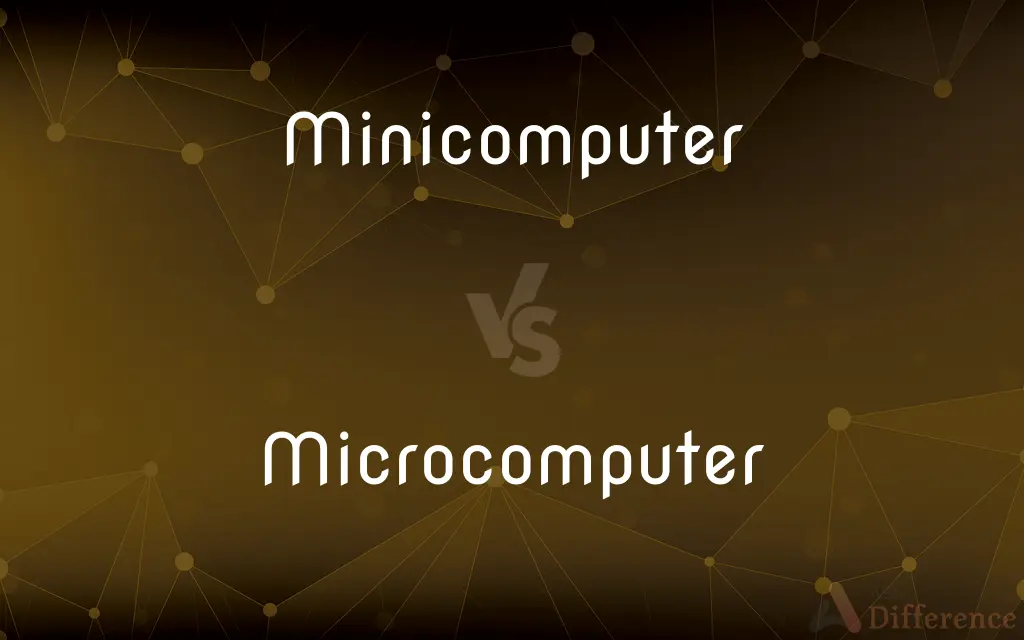Minicomputer vs. Microcomputer — What's the Difference?
Edited by Tayyaba Rehman — By Urooj Arif — Updated on March 14, 2024
Minicomputers are mid-sized, less powerful than mainframes but more powerful than microcomputers, which are small, personal computers like desktops and laptops.

Difference Between Minicomputer and Microcomputer
Table of Contents
ADVERTISEMENT
Key Differences
Minicomputers, popular from the 1960s to the 1980s, were designed for tasks that required less computing power than mainframe computers but were too demanding for early microcomputers. They were commonly used in businesses for data processing, scientific research, and industrial control. Microcomputers, which emerged prominently in the 1970s and 1980s, are personal computers intended for individual use, capable of running a wide range of software applications for personal and business purposes.
Minicomputers were significant in size, often requiring special environments and were typically accessed by multiple users through terminal connections. In contrast, microcomputers are compact, designed for use by a single individual, and can fit on a desk or be carried as laptops.
The processing power and capabilities of minicomputers were greater than those of the early microcomputers, but advancements in technology have significantly increased the power of microcomputers, making them capable of performing complex tasks that were once the domain of larger computers.
Minicomputers played a crucial role in the development of computer networks and the internet, as they were among the first to be used in research networks and small-scale business operations. Microcomputers, with their widespread availability and versatility, have become ubiquitous in homes and offices, revolutionizing the way individuals work, communicate, and entertain themselves.
Comparison Chart
Size
Mid-sized, larger than microcomputers.
Small, personal-sized devices like desktops and laptops.
ADVERTISEMENT
User Access
Multiple users via terminals.
Typically designed for individual use.
Power
Less than mainframes but more than microcomputers.
Less powerful than minicomputers, but significantly increased over time.
Usage
Data processing, scientific research, industrial control.
Personal and business applications, entertainment, communication.
Era
Popular from the 1960s to the 1980s.
Emerged in the 1970s and 1980s, still prevalent today.
Compare with Definitions
Minicomputer
A mid-range computer that is less powerful than a mainframe but more powerful than a microcomputer.
The company used a minicomputer for their payroll processing.
Microcomputer
A small, personal computer designed for individual use.
She bought a microcomputer to manage her home business.
Minicomputer
Designed for tasks requiring considerable computing power, serving multiple users.
The research lab's minicomputer facilitated complex simulations.
Microcomputer
Suitable for a wide range of applications, from word processing to gaming.
The microcomputer's versatility makes it ideal for both work and entertainment.
Minicomputer
Known for its ability to handle multiple tasks simultaneously.
The minicomputer managed various tasks, from data analysis to controlling research equipment.
Microcomputer
Can range from desktops to portable laptops and tablets.
His microcomputer collection includes both vintage and modern laptops.
Minicomputer
Often used in businesses and universities before the widespread adoption of microcomputers.
Universities used minicomputers for student registration systems.
Microcomputer
Became widely accessible to the public, revolutionizing personal computing.
The introduction of affordable microcomputers in the 1980s changed the landscape of personal computing.
Minicomputer
Could be part of a network, serving as a server or a dedicated processing unit.
The minicomputer served as the central server for the department's network.
Microcomputer
Continues to evolve, becoming more powerful and compact.
Today's microcomputers are more powerful than the minicomputers of the past.
Minicomputer
A minicomputer, or colloquially mini, is a class of smaller general purpose computers that developed in the mid-1960s and sold for much less than mainframe and mid-size computers from IBM and its direct competitors. In a 1970 survey, The New York Times suggested a consensus definition of a minicomputer as a machine costing less than US$25,000 (equivalent to $167,000 in 2020), with an input-output device such as a teleprinter and at least four thousand words of memory, that is capable of running programs in a higher level language, such as Fortran or BASIC.The class formed a distinct group with its own software architectures and operating systems.
Microcomputer
A microcomputer is a small, relatively inexpensive computer with a microprocessor as its central processing unit (CPU). It includes a microprocessor, memory and minimal input/output (I/O) circuitry mounted on a single printed circuit board (PCB).
Minicomputer
A mid-sized computer, usually fitting within a single cabinet about the size of a refrigerator, that has less memory than a mainframe.
Microcomputer
A personal computer.
Minicomputer
(computer hardware) A computer smaller than a mainframe, but larger than a microcomputer.
Microcomputer
(computer hardware) A computer designed around a microprocessor, smaller than a minicomputer or a mainframe.
Minicomputer
A mid-sized digital computer; at any given point in the development of computer technology, a minicomputer will be faster and have greater capacity than a microcomputer, but will be slower and have less capacity than a mainframe computer.
Microcomputer
A small computer based on a microprocessor; in practise, at any given time in the technology of computer development, a microcomputer will be one that is less powerful than a minicomputer.
Minicomputer
A digital computer of medium size
Microcomputer
A small digital computer based on a microprocessor and designed to be used by one person at a time
Common Curiosities
Can microcomputers serve as servers like minicomputers once did?
Modern microcomputers can serve as servers for small-scale operations, thanks to their increased processing power and capabilities.
How have microcomputers evolved over time?
Microcomputers have significantly evolved to become more powerful and compact, capable of performing tasks that were once exclusive to larger computers.
What role did minicomputers play in the development of computer networks?
Minicomputers played a crucial role in the early development of computer networks and the internet, being among the first to be used in research networks and small business operations.
How do the processing capabilities of modern microcomputers compare to those of historical minicomputers?
Modern microcomputers often surpass the processing capabilities of historical minicomputers, thanks to technological advancements in computing power and efficiency.
How has the role of microcomputers in personal computing changed since their introduction?
Microcomputers have transformed personal computing by becoming ubiquitous in homes and offices, vastly expanding their applications and impact on daily life.
How has the widespread adoption of microcomputers impacted society?
The widespread adoption of microcomputers has revolutionized how individuals work, communicate, and entertain themselves, making computing accessible to a broad public.
Were minicomputers accessible to individual users?
Minicomputers were generally not intended for individual use but were accessible to multiple users through terminals in business or research settings.
What distinguishes a minicomputer from a microcomputer?
A minicomputer is a mid-sized computer more powerful than a microcomputer but less powerful than a mainframe, designed for multiple users, whereas a microcomputer is a small, personal computer for individual use.
Were minicomputers ever used in home environments?
Minicomputers were typically not used in home environments due to their size, cost, and complexity, being more common in business and academic settings.
What factors contributed to the decline of minicomputers?
The decline of minicomputers was due to the rise of more powerful and affordable microcomputers, which could perform similar tasks at a lower cost and with greater accessibility.
Share Your Discovery

Previous Comparison
Communism vs. Nationalism
Next Comparison
Judgement vs. DecreeAuthor Spotlight
Written by
Urooj ArifUrooj is a skilled content writer at Ask Difference, known for her exceptional ability to simplify complex topics into engaging and informative content. With a passion for research and a flair for clear, concise writing, she consistently delivers articles that resonate with our diverse audience.
Edited by
Tayyaba RehmanTayyaba Rehman is a distinguished writer, currently serving as a primary contributor to askdifference.com. As a researcher in semantics and etymology, Tayyaba's passion for the complexity of languages and their distinctions has found a perfect home on the platform. Tayyaba delves into the intricacies of language, distinguishing between commonly confused words and phrases, thereby providing clarity for readers worldwide.
















































